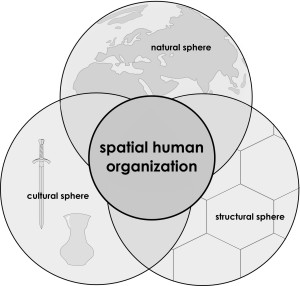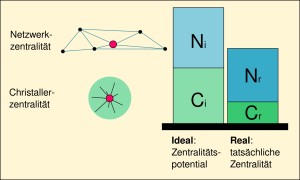Central places are sources of impetus and sensing elements for economic and cultural development in landscapes.
Certain places occur to be very important points in the settlement structure – we call them central places. These places are interrelated with their surrounding in an extraordinary high degree and can effectively submit impulses. On the other hand they are sensitive for environmental change. They do reflect the development in culture and economy. Most central places can be detected by using archaeological prestige finds and big sizes of settlement. Easy detection and significant impact on interpretation make central place research an important sub-discipline of archaeology, which focusses on the spatio-temporal development of settlement structures and society. To understand the fundamental role of central places in archaeological research we have to examine their function, conditions of development and interrelations with the environs. The research area A-I of Topoi focused on the examination of central places. Several projects conducted archaeological and geographical research on selected central places. Project A-I-21 started in fall 2010 and worked on both the theoretical fundamentals of central place research and a synthesis of all A-I’s projects.
Central places encourages interaction and allow synergy
Why are there central places in past and present? In a first place central places seem to be disadvantageous since accumulations of people efforts additional infrastructure. But we have to consider that accumulation also allows synergy. First, the concentration of people to interact with at one place does reduce the cost of transportation. Second, the probability of interaction increases where people are concentrated, what benefits trade and transfer of knowledge. Third the centralisation of production can reduce the cost per piece especially when fixed costs were high. Length of path, quality of path and cost of access to places are the factors contributing to the costs of transportation. Several single decisions preferring minimum cost of transportation tend to concentrate interacting partners at one place, the central place, just like a rational planning of settlement pattern.
Central questions to central places
When we think of (pre)historic settlements, we think about the impressive economic, cultural and political centres. Some examples could be Rome, Athens, Pergamon, Troy, Hatti, Damascus, or Babylon – a quite heterogeneous list. One could argue if it is even possible or valid to compare such places. Nonetheless, we name them with similar terms like important place, centre, or central place.
Accordingly, the question arose: What are the prerequisites to define a city with such a term? Perhaps the annual profit from trading activities? But how to measure it in times where money is not invented yet? Well, in this case the amount of trading goods or the number of trading partners could be an indicator. But this is also difficult to assess, remembering the gradually increase globalization of the societies. It get obvious that the quantitative variables are difficult to compare in this regard. Perhaps cultural aspects, like administration or cult and religion could help. An important temple for an influential god definitely increases a city’s importance. But there are many gods, and even more when different cultures are compared. What god is the most important allowing an order of places? Obviously, this is also no adequate way to interpret a cities importance in comparison to others.
We wrote about cities. Are locations like Göbekli Tepe, Jericho or Ҫatal Höyük not important or so called centres or central places because they are no cities? Obviously not.
Perhaps the location of centres could yield as a parameter to interpret their importance. If the environmental conditions are favourable for agriculture, resource exploitation and living, a place is more preferable as a location somewhere in the desert. Well, the Nabatean capital Petra is good example to falsify even these hypotheses.
All in all it seems that terms like centre or central place are empty statements. Depending from the chosen scale every place seems to be worth announced as a central place or centre. Topoi founded an entire research area called “central places and their environments” to enlarge the present theoretical base and to combine different central places to gather new knowledge about aspects that determine a locations role as a central place.
Let us state a metaphor to explain this concept. The study of ancient cities creates mosaic pieces of a hitherto unknown image. It is our aim to arrange these pieces into a theme that is able to be interpreted on its own – a work similar to that of an art historian. The interpretation of the fragmented image hints to absent features and their characteristics, allowing us to find unknown pieces more directed and to reconsider our own theories.
Integrative theory instead of paradigm change
Christaller developed central place theory in 1933. He asked for an explanation of the pattern of different sizes of cities and thought economic decisions to be the cause of this patterns. According to Christaller, central places supply a certain area in their surroundings with certain goods. A central place is the supply centre for all places being less distant than to another central place. Hence a central place has more relevancy as it would deduce from its size. Numerous settlement patterns which correspond to Christaller’s model have been found. In the previous decades research has discovered that not only distant based supply has an impact on settlement structures but also distant independent interaction. The latter dealt with network theories which are proposed to be a new paradigm replacing Christallers theory. Central places in network theory have structural advantages within the system of settlements. It is obvious that both theories do complement each other. Hence instead of replacing the old we should integrate both theories. Each central place has a certain value for Christaller-centrality and a certain value for network-centrality. In addition, we can distinguish a real centrality from a maximal centrality, the potential of centrality. Structural, environmental and arbitrary features can raise the potential of centrality. These modifications of theory allow a better understanding of central places and support the synthesis of Topoi A-I-projects. Identifying settlement patterns in empiric data with structures known from models allows us to determine explanatory variables of historic processes.
Human and the Environment – Determination, Alteration, Change
Consider the perfect natural environmental location of a city. It needs access to water as well as enough place for houses. Furthermore the environs must offer fuel and building material as well as suitable space for agriculture and pasture. Some mineral resources are always nice and close this picture of a favourable location. Following this consideration there seems to be no question where to find most important cities. They must be on the most suitable location – because who wants to spend unnecessary effort to live in a worse suitable environment? But humans act not that linear. There is more than just the direct relation between human and environmental equipment. Societal needs like trading connections or defensible locations are important, too. Or more spiritual things like the vista of an area, its genius loci, or its use a centrer of cult are important. Besides this the structural organization influences the location of cities. Every place has its own hinterland, an area that is exploited and supplied by the city, for example a city’s agricultural hinterland. It is generally not possible that other cities grow in such areas because of the great competition and the resulting lack of goods.
We speak about spheres when we try to consider all these aspects to investigate spatial human organization. Like the different spheres of the earth, i.e. atmosphere, pedosphere, lithosphere, hydrosphere, biosphere, create the complex, interchanging image of our planet, the spatial human organization is determined by the relationship of the ecosphere, cultural sphere and structural sphere. This is the framework that is able to assess and compare the importance of a location considering the different aspects that caused its evolution, success or decline.


